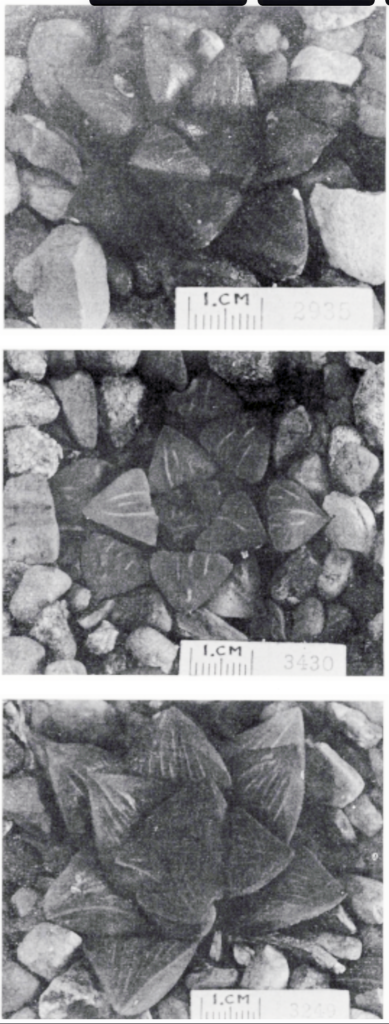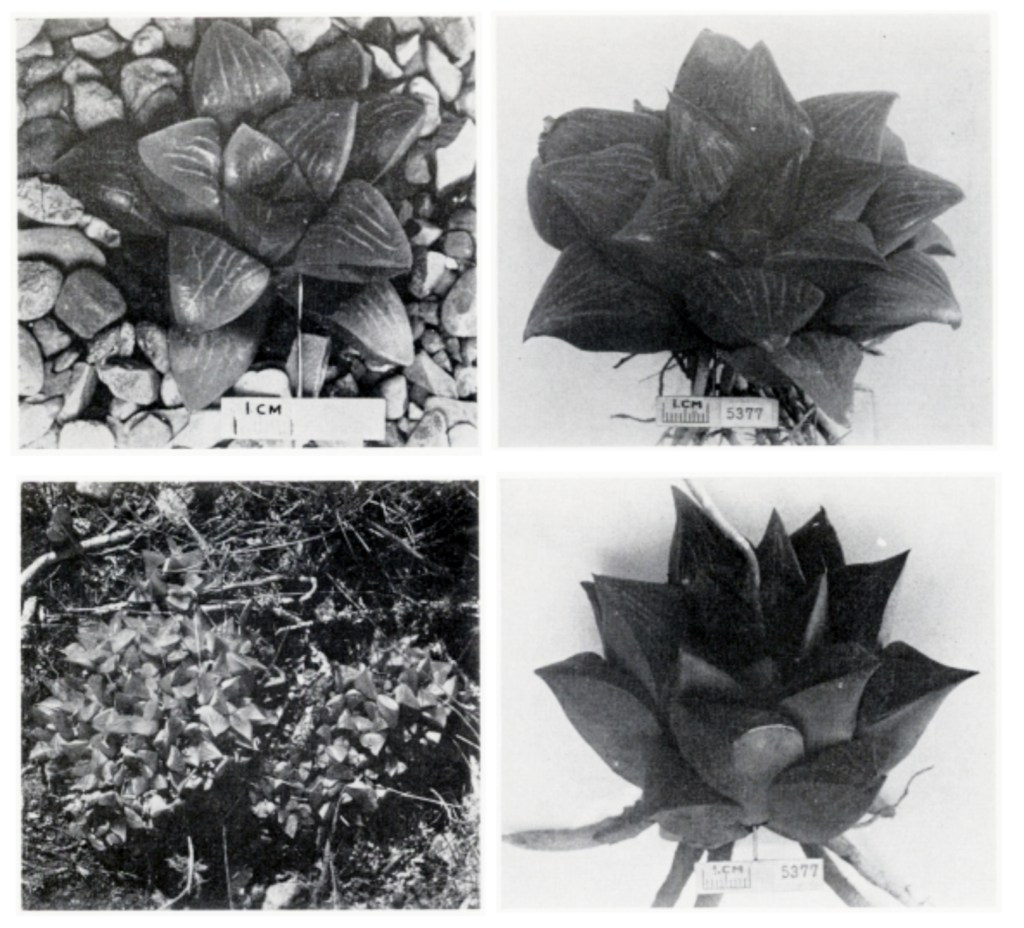G. G. Smith ‘s collection of Haworthia was donated to Kirstenbosch and the Compton Herbarium in 1950, together with an ostensible manuscript of a monograph, his basic collecting record, various catalogues of literature and odd notes. However, there was no indication of Smith’s overall view on the classification of Haworthia, or of any Intention he had for the genus at the time he abandoned work on it. On his death in February 1976, Dr M. Courtenay-Latimer obtained many remaining papers from his home. and also the Compton Herbarium became the repository on permanent loan of the entire collection belonging to the East London Museum. Among the papers Is an Immense number of detailed drawings by Dr Courtenay-Latimer of the kind which were used to illustrate Smith’s publications, as well as very detailed assessments of ‘species’. Smith accessioned all his plants individually and each plant was assessed on virtually every measurable character. It appears that Smith first considered whether a new taxon was indicated or not. and then made these numerical assessments against plants which either were, or were considered to be, existing taxa.
The papers show that Smith was in fact contemplating a whole new range of species and varieties. At the same time it is interesting to note his comment in a letter to the head of the Botanical Research Institute (as It is now named) in Pretoria. Here he says that trying to determine a species from one or two plants is a total waste of time. In a manuscript among his papers In which he concluded that the sections Obtusatae and Planifoliae were synonymous, he writes: ” In some cases with different plants from the same locality and even from the same cluster. it was possible to place some In each section.” This is a significant remark which collectors should note as even von Poellnitz described H. cymbiformis var. translucens and H. planifolla var. transiens from the same collection.
Smith seems to have been particularly Involved with the sections Trlfariae, Coarctatae, Obtusatae and Retusae as they then existed. In the section Obtusatae he had proposals for 13 new species, 18 varieties and two sub-varieties. All these are simply referred by the writer to H. cymbiformis (Haw.) Duval. In the Retusae he did not propose any new species but instead visualized 21 new varieties, two sub-varieties and a forma. In the case of H. nitidula v. Poelln. he had nine varieties in fact were drawn from the species H. mirabilis Haw., H. retusa (L.) Duval and H. emelyae v. Poelln. The accompanying illustrations show that H. emelyae v. Poelln, and H. mutica Haw. were both confused with H. pygmaea v. Poelln., while H. mutica and H. retusa were also confused. In H. turgida Haw. Smith proposed seven new varieties. In the sections Fusiformes, Fenestratae, Loratae and Limipdae there were descriptions of one new variety in each; in the section Muticae that of one new species and two varieties, and in the Denticulatae one new species.
In the Trifariae there were proposals for four new species and 14 varieties in a species which is really not so particularly variable, i.e. H. viscosa (L.) Haw. It is in fact difficult to detect the differences in these supposed varieties from the photographs accompanying the descriptions. Finally in the Coarctatae there were descriptions of six new varieties of H. reinwardtii Haw., two of which actually belonging with H. coarctata Haw. This gives a grand total of 19 possible new species, 65 varieties, four sub-varieties and a forma.
Smith’s assessments involved detailed measurements and observations of as many as 56 different variables and should serve as a salutary lesson for any budding taxonomist. There is just no sense in arguing about trivia. The species are highly variable and in many cases are not clearly definable to the exclusion of other species. While each and every clone of Smith’s collection could ultimately have had a name involving three or four epithets, there is no justification for ridiculing this aspect of his work. Together with Dr Courtnay-Latimer, Smith left an herbarium record unrivalled in the Liliaceae and perhaps only by Dr L. Bolus’ equally invaluable contribution to a permanent record in the Mesembryanthemaceae.

Fig. 1 (top): GGS 2935 HAWORTHIA EMELYAE v. Poelln. From Uniondale – ‘H. pygmaea var. A. Smith’.
Fig. 2 (centre): GGS 3430 HAWORTHIA MUTICA Haw. From Bonnievale – ‘H. pygmaea var. B. Smith’.
Fig. 3 (bottom): GGS 3249 HAWORTHIA MUTICA Haw. From Stormsvlei – ‘H. retusa var K. Smith’.

Fig. 4 (top left): GGS 5061 HAWORTHIA MUTICA Haw. From Swellendam – ‘H. retusa var. J. Smith’.
Fig. 5 (bottom left): GGS 5377a HAWORTHIA RETUSA (L.) Duv. From E. Riversdale – ‘H. retusa var’. (H. geraldii Scott). A large clump.
Fig. 6 (top right): GGS 5377a HAWORTHIA RETUSA (L.) Duv.
Fig. 7 (bottom right) GGS 5377b HAWORTHIA RETUSA (L.) Duv. From E. Riversdale – ‘H. retusa var.’.
by M. B. Bayer
Photos by the author.
Nat. Cact. & Succ. J., Vol. 37/4 (1982) pp 105-106.
